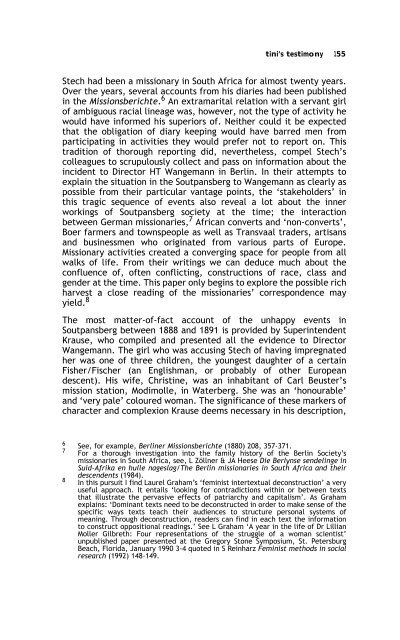Sex, Gender, Becoming - PULP
Sex, Gender, Becoming - PULP
Sex, Gender, Becoming - PULP
You also want an ePaper? Increase the reach of your titles
YUMPU automatically turns print PDFs into web optimized ePapers that Google loves.
tini’s testimony 155<br />
Stech had been a missionary in South Africa for almost twenty years.<br />
Over the years, several accounts from his diaries had been published<br />
in the Missionsberichte. 6 An extramarital relation with a servant girl<br />
of ambiguous racial lineage was, however, not the type of activity he<br />
would have informed his superiors of. Neither could it be expected<br />
that the obligation of diary keeping would have barred men from<br />
participating in activities they would prefer not to report on. This<br />
tradition of thorough reporting did, nevertheless, compel Stech’s<br />
colleagues to scrupulously collect and pass on information about the<br />
incident to Director HT Wangemann in Berlin. In their attempts to<br />
explain the situation in the Soutpansberg to Wangemann as clearly as<br />
possible from their particular vantage points, the ‘stakeholders’ in<br />
this tragic sequence of events also reveal a lot about the inner<br />
workings of Soutpansberg society at the time; the interaction<br />
between German missionaries, 7 African converts and ‘non-converts’,<br />
Boer farmers and townspeople as well as Transvaal traders, artisans<br />
and businessmen who originated from various parts of Europe.<br />
Missionary activities created a converging space for people from all<br />
walks of life. From their writings we can deduce much about the<br />
confluence of, often conflicting, constructions of race, class and<br />
gender at the time. This paper only begins to explore the possible rich<br />
harvest a close reading of the missionaries’ correspondence may<br />
yield. 8<br />
The most matter-of-fact account of the unhappy events in<br />
Soutpansberg between 1888 and 1891 is provided by Superintendent<br />
Krause, who compiled and presented all the evidence to Director<br />
Wangemann. The girl who was accusing Stech of having impregnated<br />
her was one of three children, the youngest daughter of a certain<br />
Fisher/Fischer (an Englishman, or probably of other European<br />
descent). His wife, Christine, was an inhabitant of Carl Beuster’s<br />
mission station, Modimolle, in Waterberg. She was an ‘honourable’<br />
and ‘very pale’ coloured woman. The significance of these markers of<br />
character and complexion Krause deems necessary in his description,<br />
6 See, for example, Berliner Missionsberichte (1880) 208, 357-371.<br />
7 For a thorough investigation into the family history of the Berlin Society’s<br />
missionaries in South Africa, see, L Zöllner & JA Heese Die Berlynse sendelinge in<br />
Suid-Afrika en hulle nageslag/The Berlin missionaries in South Africa and their<br />
descendents (1984).<br />
8<br />
In this pursuit I find Laurel Graham’s ‘feminist intertextual deconstruction’ a very<br />
useful approach. It entails ‘looking for contradictions within or between texts<br />
that illustrate the pervasive effects of patriarchy and capitalism’. As Graham<br />
explains: ‘Dominant texts need to be deconstructed in order to make sense of the<br />
specific ways texts teach their audiences to structure personal systems of<br />
meaning. Through deconstruction, readers can find in each text the information<br />
to construct oppositional readings.’ See L Graham ‘A year in the life of Dr Lillian<br />
Moller Gilbreth: Four representations of the struggle of a woman scientist’<br />
unpublished paper presented at the Gregory Stone Symposium, St. Petersburg<br />
Beach, Florida, January 1990 3-4 quoted in S Reinharz Feminist methods in social<br />
research (1992) 148-149.
















